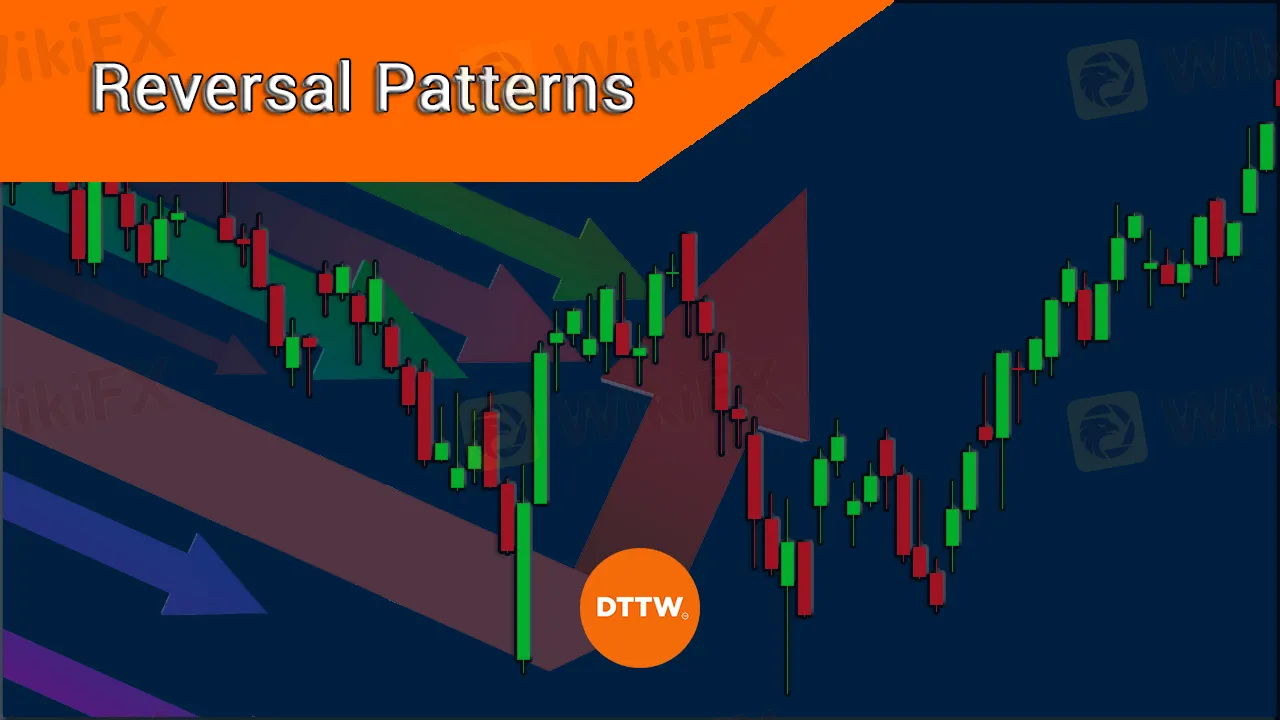简体中文
繁體中文
English
Pусский
日本語
ภาษาไทย
Tiếng Việt
Bahasa Indonesia
Español
हिन्दी
Filippiiniläinen
Français
Deutsch
Português
Türkçe
한국어
العربية
How to Trade Reversal Patterns in Forex?
Abstract:When investing on forex, a trader has to be able to get familiar with chart patterns. Chart patterns are the basis of technical analysis and require a trader to know exactly what they are looking at, as well as what they are looking for.

In the first two days, we talked about two types of of chart patterns: flag patterns and triangle patterns. Today we are going to introduce reversal patterns, one of the two general categories of chart patterns.
In this post, we will discuss the definition of reversal patterns, and different types of reversal patterns, and how to trade reversal patterns.
What Are Reversal Patterns?
They can be divided into two general categories: continuation patterns and reversal patterns.
A reversal pattern is a transitional phase that marks the turning point between a rising and a falling market. If prices have been advancing, the enthusiasm of buyers has outweighed the pessimism of sellers up to this point, and prices have risen accordingly.
During the transition phase, the balance becomes more or less even until finally, for one reason or another, it is tipped in a new direction as the relative weight of selling pushes the trend down. At the termination of a falling market, the reverse process occurs.
Reversal patterns might signal that either the bulls or bears have lost control and that there might be a change of trend imminent. The current trend will see a pause and then the price will move in a new direction from the other side (bull or bear).
What Are the Most Important Reversal Patterns?
While there are many reversal patterns to consider, we put together a list below, identifying some of the most common ones to add on your charts:
Head and shoulders is considered to be one of the most reliable reversal chart patterns. True to its name, this pattern is comprised of a large peak in the middle and smaller peaks on the either sides, which looks like a head with two shoulders. The head and shoulders pattern forecasts a downward movement of the price.

As the chart above, the first and third peak will be smaller than the second, but they will all fall back to the same level of support, otherwise known as the 'neckline'. Once the third peak has fallen back to the level of support, it is likely that it will breakout into a bearish downtrend.
2. Reverse Head and Shoulders
Conversely, the reverse head and shoulders pattern appears after a bearish trend, forecasting an upward movement. While the HS signals the end of an uptrend, a HS bottom indicates that a downtrend is over and prices could be about to rise.

The pattern is identified when the price action meets the following characteristics: the price falls to a trough and then rises; the price falls below the former trough and then rises again; finally, the price falls again but not as far as the second trough.
3.Double Top
A double top is another bearish reversal pattern that traders use a lot. It has two peaks, indicating waning interest among buyers and the possibility of a downtrend. The “tops” are peaks that are formed when the price hits a certain level that can't be broken. After hitting this level, the price will bounce off it slightly, but then return back to test the level again.

In the chart above you can see that a top was formed after a strong move up and then retrace back to a level of support. It will then form a peak once more before reversing back from the prevailing trend.
4. Double Bottom
On the contrary, the double bottom pattern is bullish reversal pattern that is totally opposite of double top. This pattern has two low price valleys which predict an upward trend as buyer interest is piqued.

You can see from the chart above that after the previous downtrend, the price formed two valleys because it wasn't able to go below a certain level. Then the price broke the neckline and made a nice move up.
How to Trade Reversal Patterns?
Once any of the aforementioned conditions signal a potential turn-around, we look for a price breakout in the opposite direction.
There are different ways to trade a reversal, from revisiting a support/resistance level to waiting for a valid retest of the first breakout level and then taking a trade. A good breakout to keep in mind is the neckline breakout.
A neckline is an area of diagonal support or resistance, or a trendline if you will. This keeps prices trending for an extended period of time when not breached. In our case, we are looking for this trendline to weaken and break for a reversal to commence, hence, a valid trade.
Main rules of trading reversals:
· do not try to be the first and catch the very high or very low, although you also shouldn't enter a reversal too late when the price already ran away from the extreme point;
· follow the rules by which you trade reversals, for example, local price low, positive delta and buyers that got stuck at the bar low;
· accept loss-making trades without emotions. Reversal patterns do not always work. If you want to win back after a loss-making trade, perhaps, reversals is not your trading strategy;
· do not persist in searching for a reversal on trend days. Of course, the price would reverse sooner or later but, perhaps, it would not be today and not after the deposit expires.

Disclaimer:
The views in this article only represent the author's personal views, and do not constitute investment advice on this platform. This platform does not guarantee the accuracy, completeness and timeliness of the information in the article, and will not be liable for any loss caused by the use of or reliance on the information in the article.
Read more

WikiEXPO Dubai 2025 Concludes Successfully — Shaping a Transparent, Innovative Future
On November 11, WikiEXPO Dubai 2025, hosted by WikiGlobal and co-organized by WikiFX, successfully concluded. As one of the world’s most influential Fintech expos, this event brought together more than 570 regulatory representatives, industry leaders, and innovation pioneers from across the globe. Through in-depth discussions on core issues such as regulatory compliance, the forex market, investment strategies, and sustainable finance, the event delivered a profound experience that masterfully blended intellectual depth with actionable insights.

The 5%ers Review: Is it a Scam or Legit? Find Out from These Trader Comments
Did you face reduced leverage and hiked fees without any explanation from The 5%ers broker? Do you find The 5%er rules strange for getting a funded account from this prop trading firm? Has the broker closed your trade inappropriately, preventing you from making gains in the forex market? All these allegations have dominated The 5%ers review segment online. Looking at this, the WikiFX team investigated and found some startling comments against the broker. In this article, we have shared those complaints. Read on!

BROKSTOCK Exposed: Traders Report Login Errors, Withdrawal Issues & Incompetent Customer Support
Is your BROKSTOCK trading account full of inefficiencies? Do the recurrent BROKSTOCK login errors prevent you from opening and shorting positions at a favorable price? Has the broker failed to honor your withdrawal requests? Do you face order execution price issues? Has the customer support service failed to resolve your queries? You are not alone! In this BROKSTOCK review article, we have shared some complaints that need a close introspection. Read on to explore them.

OmegaPro Review: Traders Flood Comment Sections with Withdrawal Denials & Scam Complaints
Has your deposit and withdrawal scenario worsened after the initial good experience at OmegaPro, a UK-based forex broker? Does the broker ask you to invest when withdrawing your funds? Did the broker officials trap you with their false promises of compound interest on your deposit? Have you found it impossible to transfer funds from your OmegaPro login to another broker’s account? Do you witness a lack of support when dealing with these unfortunate trading circumstances? These are no longer isolated complaints — they have allegedly become the reason for OmegaPro’s tarnished trust and reputation within the trading community. Read on as we share the OmegaPro review in this article.
WikiFX Broker
Latest News
BASF CEO: EU CO₂ Trading Is A "Destruction Mechanism" For European Industry
Is Fyntura a Regulated Broker? A Complete 2025 Broker Review
Zetradex Exposed: Withdrawal Denials, Account Freeze & Bonus Issues Hurt Traders
Is Forex Zone Trading Regulated and Licensed?
PINAKINE Broker India Review 2025: A Complete Guide to Safety and Services
Exness Restricted Countries List 2025 Explained
Is Uniglobe Markets Legit? A 2025 Simple Guide to Its Safety, Services, and User Warnings
Is Inzo Broker Safe or a Scam? An Evidence-Based Analysis for Traders
WikiEXPO Dubai 2025 “Welcome Party” Kicks Off Tonight!
He Trusted a WhatsApp Group and Lost RM659,000
Currency Calculator



